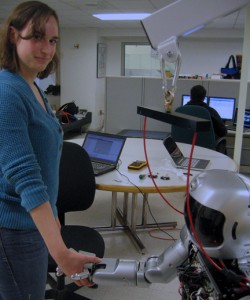Isaac Asimov’s enduring vision of life-like robots is taking a step closer to reality through research by Alyssa Batula ’09. A third-year Ph.D. student in electrical engineering at Drexel University, she is not only advancing artificial intelligence foretold in Asimov’s I, Robot series, but is deepening science’s understanding of human creativity.

Alyssa Batula '09 shakes hands with HUBO.
A National Science Foundation Graduate Research Fellow, Batula is blending science and music as a research assistant in the Music Entertainment Technology Laboratory (MET-Lab) led by Youngmoo Kim, associate professor and assistant dean of media technologies at Drexel.
They are using digital signal processing and machine learning to “teach” robots to be interactive participants in a music ensemble, through dancing or playing an instrument. Batula is developing a humanoid pianist with the capacity to interpret and respond to audio and visual feedback.
The work combines two interests that Batula pursued at Lafayette, electrical & computer engineering and music. She played French horn in the concert band.
She was introduced to robotics at Lafayette’s inaugural Autonomous Robotics Competition. She and Kavinda Udugama ’09 programmed a Hemisson robot to visit five targets in a competition-winning time of just 15 seconds.
The experience was one of many that supported her studies in a student-focused environment.
“One of the things I like most about the [electrical and computer engineering] department is that it is a small community,” says Batula. “All of the professors know who you are and how you’re doing. I felt that I could go to any of them with a question about anything—from a class to my plans for the future.”
View a video of Batula describing a beat-tracking program for teaching a robot to dance
“We’re fuzzy about processes associated with human creativity. For example, most of us can tell if something is off-pitch, but we’re not sure how we know,” she says. “To program a robot, we have to tell it exactly what to do. So, we look into what is it that we hear that helps us identify beat or tone. In the process, we learn more about how humans perceive music.”
Batula completes a three-their system of new motions on RoboNova, a small prototype humanoid robot. She then applies the programming to the life-sized HUBO, developed by the Korean Advanced Institute for Science and Technology.
Watch RoboNova and HUBO performances
Batula is also a student fellow in an NSF-funded project to encourage education in the STEM (science, technology, engineering, and mathematics) fields. The project links STEM learning with the National Academy of Engineering’s Grand Challenges program.
In the future, Batula plans to work in the field of medical robotics.
“I’m interested in advanced prosthetic devices that individuals can control,” she says, which could increase mobility for people with handicaps. “The end goal is different, but the methods are similar to our current research.”

1 Comment
Comments are closed.